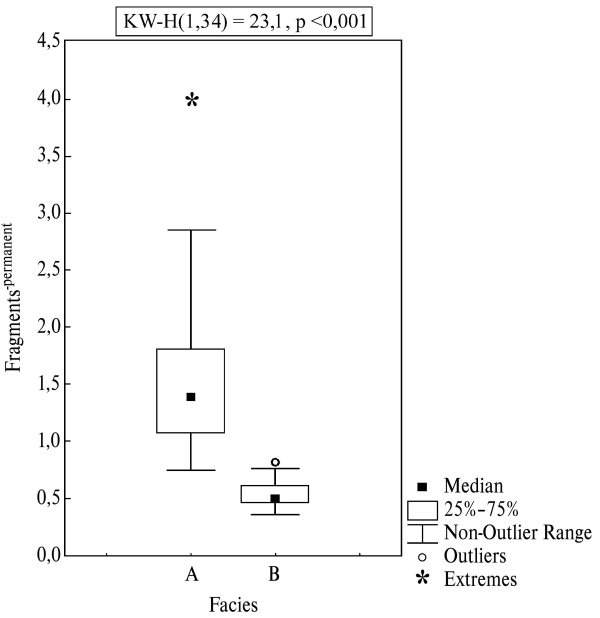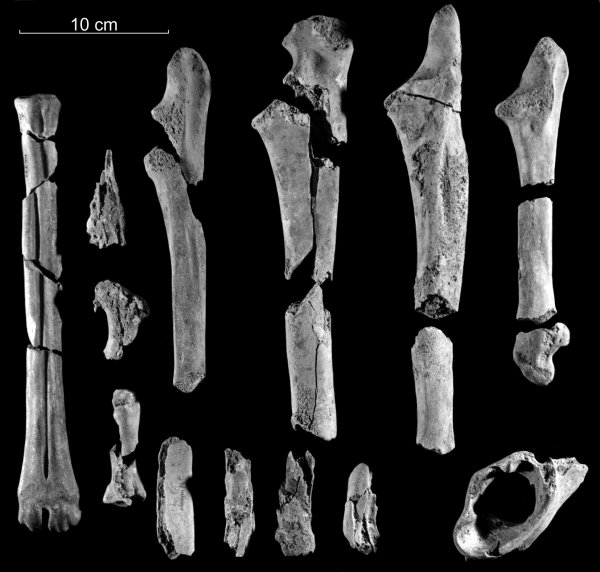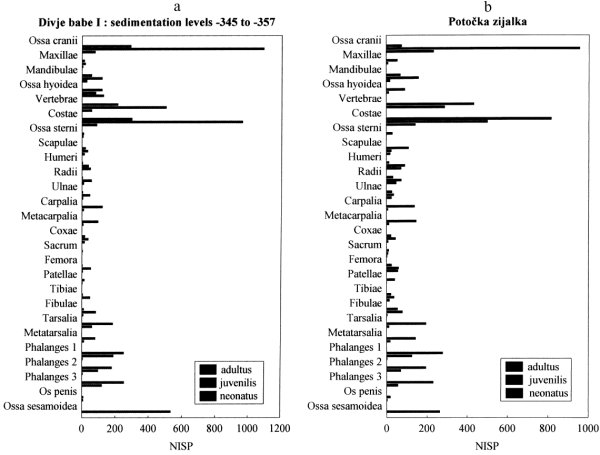 Institute of Archaeology Institute of Archaeology |
[Slovenian] |
| Home | Members | Programme | Projects | Laboratory |
| Database | Publications | Library | Links | Archive |
|
DIVJE BABE I. Upper Pleistocene Palaeolithic site in Slovenia 12. Cave bear at the Divje babe I site: taphonomic-stratigraphics analysis
12.1. Introduction to taphonomic analysis Abstract All remains of cave bear obtained by wet sieving on sieves of gauge 0.5 mm, 3 mm and 10 mm, from a block of stratified sediments with a volume of 95 m3 from area B and part of area A of the excavation field, were systematically processed quantitatively and qualitatively. Since the sediments of all stratigraphic units, i.e., sedimentation levels, in the block have the same volume (see Chapter 1 in this volume), in processing the finds it was not necessary to operate with their shares or to weight the finds. The block of sediments represents only 5% of all available volume in the stratigraphic series of the site, but is sufficiently representative in cases when it contains large numbers of finds and analytical data, which is normal for a block. An additional experiment showed that only data collected in sedimentation levels with an area greater than 15 m2 are entirely reliable. The area of each sedimentation level in the block was 21 m2. Abstract The authors analysed isolated teeth quantitatively and qualitatively in a block of sediments divided into two parts (Facies A and B), which together cover 35 stratigraphic units, i.e., sedimentation levels. They found that there are more milk teeth in Facies A, but fewer milk canines, including canines with resorbed roots. There are also more lower teeth and adult canines, as well as tooth fragments. They explain the differences by changes in the structure of the bear population present in the cave, which was influenced by climate, mainly precipitation and the activities of palaeolithic man, who presumable carried off skulls and canines. The differences in the facies are in accordance with differences that are based exclusively on sedimentological data. It is not possible to distinguish between layers on the basis of individual finds of teeth..
12.3. Fragmentation of anatomically definable bones and other characteristics of bone remains Abstract The authors analysed bone remains quantitatively and qualitatively in a block of sediments divided into two parts (Facies A and B), which together cover 35 stratigraphic units, i.e., sedimentation levels. They found that the bones of juvenile and neonatal individuals are more fragmented than the bones of adult individuals in both facies. In the group of juvenilis and neonatus there is an average of ten times more fragments per whole bones than in the group adultus. There are on average fifteen times more juvenile than adult diaphyses. All bone fragments in Facies A are smaller and more numerous. There are more bones with traces of biting in Facies A, a nd juvenile and neonatal bones are more fragmented. In Facies A, there are more bones of juvenile individuals in the upper part. The authors explain the differences between facies by the activity of carnivores and humans, and the difference within Facies A by changes in the structure of the bear population present in the cave. The differences between facies are in accordance with differences that are based exclusively on sedimentological data. Differentiation between individual layers is not possible on the basis of bone finds. In connection with the heading "gnawed bones" in Tab. 12.3.1 the authors stress that there are no pierced bones among them. There are only those with the impressions of teeth on juvenile metaphyses, and exceptionally on adult epiphyses. There is only one "pierced" bone in the entire sample, on the proximal metaphysis of a juvenile femur, with a etched hole, found in quadrat 23 at a depth of -273 cm. They stress this in particular because of the bitter polemics about the find of a suspected bone flute in quadrat 17 at a depth of -285 cm, which some experts try to explain as the product of carnivore activity, referring to the general phenomenon of pierced bones at sites with cave bear (d'Errico et al. 2003, 35pp). Among 89,811 identifiable bones examined, there is only one bone pierced more than once, which is interpreted as a suspected flute (Turk et al. 1995b; 2005b) and one bone pierced a single time, which, in view of the position of the hole close to the epiphysis, may possibly be explained as a carnivore product. The first author and M. Brodar have already reported several times on the relatively small number of other pierced bones from the site (Brodar 1999, Tab. 6: 8,9; Turk 1984-1986, 10; Turk et al. 2001b, Tab. 5, Fig. 19). Pierced bones in Divje babe I are in no sense a general phenomenon, but at most an exceptional phenomenon.
12.4. Representation of skeletal parts Abstract The authors quantitatively and qualitatively study the representation of skeletal parts among ontogenetic groups in the block of sediments from 35 stratigraphic units and two facies (A and B). They found differences in ontogenetic groups of skeletal parts such as neonatus, juvenilis and adultus. Juvenile skeletal parts are best represented, neonatal worst. Representation is worse with all groups in the upper part of the profile, where there are fewer skeletal parts. The number of finds has a major impact on the representation of skeletal parts. The degree of fragmentation also has a certain influence. There are both quantitative and qualitative differences with some skeletal parts between the upper and lower parts of the profile (Facies A and B). In Facies A, there are more skull fragments, despite the smaller number of skulls and there is also greater fragmentation of adult humeri and tibias.T he results of analysis and the exceptional find of a fairly complete adult skeleton of a cave bear female in Facies B, which lacks one each humerus and femur show that some large marrowbones could have been removed from the site, and skulls intentionally smashed. In connection with skulls, the authors mention two exceptional finds of skulls, which may be evidence that palaeolithic people actually did something with them.
The first is the skull of an adult cave bear male no. 2349, found at the bottom of Layer 8 among rockfall blocks in quadrat 39, cut -333 cm (=sedimentation level -345 cm), 4 m away from a hearth. The skull has symmetrical holes in both massive spurs behind the mandibular articular depression (fovea articularis mandibulae) and the wider vicinity of the foramen occipitale magnum has been damaged after deposition or during removal of the brains. Certainly some minor damage occurred post-sedimentarily because of etching. The symmetry of the pair of holes behind the mandibular artcular depression is unusual. The position and size of the holes is similar unusual. The authors do not therefore exclude the possibility that the holes were made for the purpose of strongly attaching or hanging the skull. In addition, the skull lay on the vertex, which is also unusual, supported by two stones. The mouth was turned towards the west. In parallel with it, 12 cm higher lay on the vertex an additional skull of an adult cave bear, this time female no. 2033. This was undamaged, with the mouth turned towards the east with a slight deflection towards the south. Since the skulls were touching, it is not excluded that the deviation of skull no. 2033 occurred post-sedimentarily. Certainly all the aforementioned (position, orientation, sex, damage) is very difficult to explain by pure coincidence. Finally, the authors compared the representation of skeletal parts in Divje babe I and two Aurignatian cave sites: Potočka zijalka in Slovenia and Chauvet cave in France where a unique fossil floor was preserved. They found considerable differences, despite the similar types of site. They ascribe them to the different structures of cave bear population that visited these caves in more or less different time periods. *** 2007, (Opera Instituti Archaeologici Sloveniae, 13), 480pp, 10 colour photoogaphs, 178 b-w drawings, photoogaphs and maps, 89 tabels and 38 annexes; 20 x 29 cm, hardcover, ISBN 978-961-254-019-7. |


